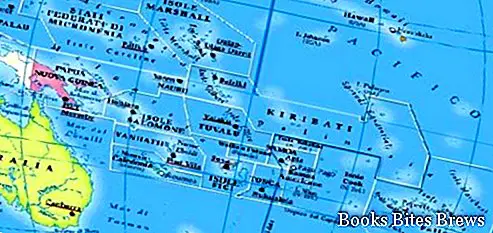Composition of the continent of Oceania, which states and islands make it up, climate, flora and fauna, population and history of the first explorations.
Characteristics of the continent Oceania
Oceania includes the Australian continent, including Tasmania, New Guinea, New Zealand and a large number of islands and smaller archipelagos, located in the Pacific Ocean, and conventionally grouped in Melanesia, Micronesia and Polynesia.
The main aspects are represented by the insularity, bearing in mind, however, that 86% of its emerged area consists of Australia, and the geological and morphological contrasts of the territories that constitute it.
From the vast and ancient tabular surfaces of Australia, we move on to the harsh forms of New Guinea and New Zealand, to the volcanic structures and atolls that form numerous islands.
Climate Oceania
A decisive element is the distribution of the emerged lands with respect to the Ocean, since the strongest thermal contrasts occur in the regions of the Australian interior with a continental climate, characterized by strong annual temperature variation and low rainfall.
Most of the islands, included in the intertropical region, have a uniform climate with temperatures mitigated by winds (monsoons, trade winds, breezes) and conspicuous rainfall.
New Zealand and the coasts of Southeast Australia have a temperate climate.
Hydrography
The hydrographic network is poorly developed, the most relevant rivers flow only in Australia (Murray-Darling), New Zealand, Tasmania and New Guinea.
Eyre, low and brackish, is the most important lake and is located in the lowlands north of the Australian Great Bay.
Flora and fauna
The vegetation of Oceania is characterized by a marked endemism, favored by ocean isolation. There are the tropical forest, the arboreal savannas, with pines and eucalyptus, and bushy steppe areas.
Temperate forests extend over much of New Zealand, while over coral atolls
typical vegetation is represented by palm trees.
- Fraser (Australia): what to see on the island
- New Caledonia (Oceania): what to see
- Sydney (Australia): what to see
- American Samoa: useful information
- Oceania: useful information
The fauna of Oceania is similar to that found in Australia, characterized by many species of Marsupials, Monotremes, primitive Birds and more.
Population
Oceania is the least populated part of the world.
However, the population density is irregularly distributed, in Australia, for example, there are vast areas depopulated inside, and large densities along the coasts.
The population is made up of very heterogeneous elements and is mostly made up of whites, the consequence of strong immigration, while indigenous people are found in prevalent numbers on the islands.
Ethnography
From an ethnographic point of view, Oceania is a true mosaic of races, among the most primitive endangered, the Australian, the Tasmanian and the Melanesian stand out.
Pigmoids and communities belonging to the Papuan race also live in the internal regions of New Guinea.
In the various archipelagos of Micronesia and Polynesia, the Polynesian race is present, while in Melanesia the inhabitants are of heterogeneous races.
Economic geography
Agriculture has undergone considerable development after European immigration, with the main products being wheat, sugar cane, fruit and citrus fruits.
Very important is the breeding, especially sheep, which allows Australia to be among the world's largest wool exporters.
Mining products include gold, lead, zinc, uranium, lignite, coal, oil, natural gas, bauxite, iron (Australia, New Caledonia), copper and silver (Papua New Guinea), nickel (New Caledonia), phosphates ( Nauru).
Precious hardwood is made from equatorial forests.
Industrial activity is highly developed in Australia and New Zealand.
Explorations of Oceania
It was Ferdinando Magellano on his journey through the Pacific Ocean (1519-21) who, with the discovery of the Mariana Islands, opened the phase of the discoveries of Oceania, of which until then there was little news.
In the seventeenth century Spaniards and Dutch contributed to increase knowledge of this
new world (Torres, 1606; Tasman, 1642), but it was above all with J.Cook, with his three journeys between 1768 and 1779, that more exact data were given on Oceania.
History
England, after the founding of the first penal colonies in Australia, quickly took over the whole territory by annexing it to the Crown (1826).
The same procedure was adopted for New Zealand, over which England proclaimed its sovereignty in 1840.
At the same time, French, American and English Catholic and Protestant missionaries arrived on the territory, at the forefront of a new colonization process, since at the end of the century Oceania was divided between France, Germany, the USA and England.
During the Second World War, between 1941 and 1945, Oceania was the subject of clashes between Japan and the United States supported by Australia and New Zealand.
After the war he stably entered the American sphere of influence.
A process of decolonization began in 1960 which led to the independence of most of the archipelagos of Oceania.




